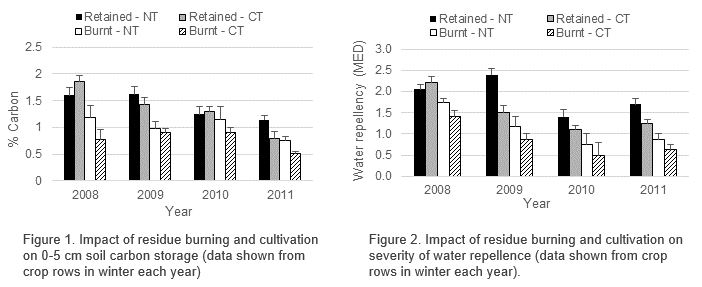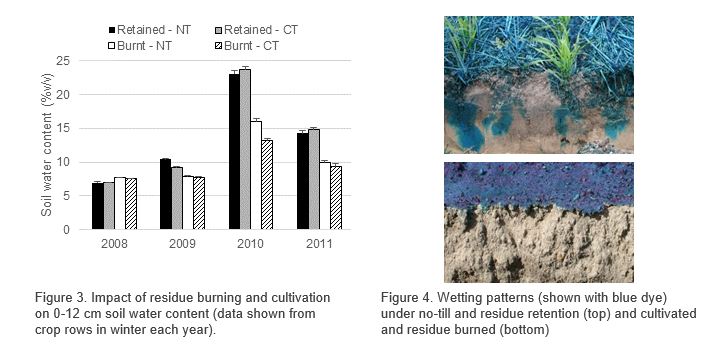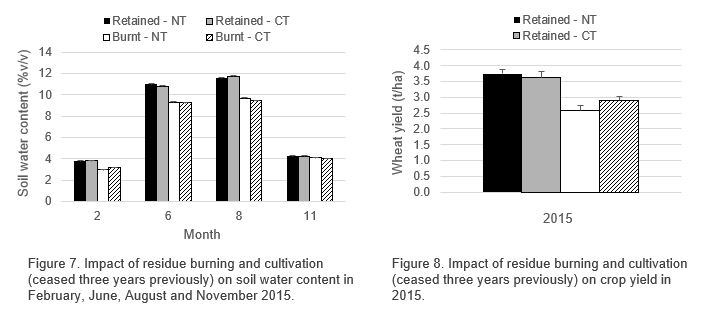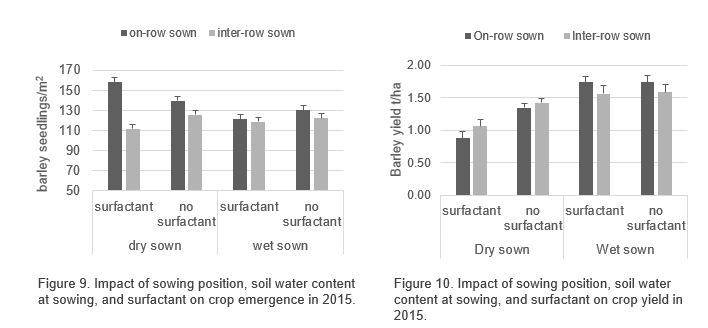Managing water repellency with minimal soil disturbance
Author: Ramona Kerr, Phil Ward, Margaret Roper, Shayne Micin, CSIRO, Stephen Davies, DAFWA | Date: 23 May 2019
Key Messages
- No-till and residue retention provide an effective management strategy for crop production in water repellent soils, and the techniques can be used either on their own, or to complement amelioration strategies based around strategic deep cultivation.
- Preserved root pathways in no-till systems can by-pass water repellent soil and allow rainfall to infiltrate. The resulting higher moisture contents in the furrows can facilitate crop emergence; growers can take advantage of this by planting near the old crop row.
- Where feasible, water repellent paddocks should be sown last in the seeding program in order to avoid dry-seeding which can worsen the symptoms of water repellency.
Background & Aims
Soil water repellency is identified as one of the major constraints to agricultural production in southern and Western Australia, affecting up to 10 million hectares of sandy soils. Water repellency is caused by hydrophobic plant waxes and microbial by-products that break down and mix with or coat soil particles. The tell-tale sign of dry patches of soil, even after substantial rainfall, can cause poor crop establishment and staggered weed germination, leading to poor crop performance, increased weed management costs, leaching of nutrients through preferential flow and the risk of soil erosion.
Some growers are using intensive one-off cultivation such as mouldboard ploughing or spading to overcome water repellency by inverting or mixing the water repellent top soil with deeper, more wettable subsoil. Whilst these methods immediately ameliorate the symptoms of water repellency and improve water infiltration, they are costly to implement on a large scale, and the upheaval of the soil profile can prove challenging for establishment of seedlings and increases the risk of wind erosion in the short term.
Several growers in WA are successfully managing water repellent soils for crop production using no-till and full stubble retention. In this research we aim to determine the impact of no-till and stubble retention on water repellency and patterns of water movement into the soil, and impacts on subsequent crop production. Aspects of row placement (either between the previous crop rows, or close to previous crop rows), wet versus dry seeding, and the use of a surfactant, were also investigated.
Method
Field trials were established at Munglinup and Pingrup in the WA wheatbelt. At Munglinup, a paddock was chosen with a long history of no-till and residue retention in 2007. Treatments included residue removal by burning versus continued residue retention, and a single shallow (10 cm) cultivation at seeding (CT) versus no-till (NT), with 4 replicates, in plots of 12 m by 12 m. Treatments were applied annually to each plot until 2012, when the entire trial reverted to no-till and stubble retention to assess the speed of recovery from cultivation and stubble burning.
At Pingrup, treatments included inter-row versus on-row seeding (using the iTILL® system), wet versus dry seeding, and furrow-applied surfactant versus no surfactant. Wet versus dry seeding was tested using seeding either side of a rainfall event in 2015, and using artificial rain shelters in 2016.
At both trials, soil water repellency (Molarity of Ethanol Droplet, MED) and soil carbon were measured at soil depths of 0-5 and 5-10 cm on soil samples taken several times per year from several locations per plot. At the same times, soil water contents were measured in ‘in-row’ and ‘inter-row’ locations to a depth of 12 cm in at least 10 random locations per plot. Crop emergence and grain yield were assessed each year.
Results
Munglinup
At the Munglinup trial, both cultivation and residue removal by burning resulted in decreases in soil carbon and water repellence severity (Figures 1 and 2: in all figures, error bars represent the standard error of the mean). Despite the decrease in water repellence, soil water contents, particularly in the crop row, were lower in the plots with cultivation and residue burning (Figures 3 and 4). As a result, crop emergence and grain yield were often higher in the no-till, residue retained plots (Figures 5 and 6).
After reinstating no-till and residue retention in 2012 over the whole trial, soil water contents and crop performance were still affected in 2015 (Figures 7 and 8). Crop yields for 2016 are not shown because the trial was adversely affected by waterlogging, with average canola yields of 0.4 t/ha.
Pingrup
At the Pingrup trial in 2015, sowing close to the old crop row significantly increased crop emergence when the crop was sown under dry conditions, but had little impact when wet-sown (Figure 9). However, crops sown into wet soil about 1 week later than crops sown into dry soil yielded significantly better than the dry sown crops (Figure 10).
In 2016, crop emergence was significantly greater in the wet sown crops than in the dry sown crops (Figure 11), and this carried through to crop yield, particularly where surfactant was applied (Figure 12). There was little consistent impact of seed placement or surfactant on crop emergence or grain yield in 2016.
Throughout the trial, soil water repellency was lower in the crop or stubble rows than in the inter-row locations. For example, in March 2015, water repellency in the stubble rows averaged MED 1.3, but the MED was 2.2 in the inter-row locations. This is probably due to microbial decomposition in the old crop rows, where water contents tend to stay higher for longer, allowing greater microbial activity. Averaged across 9 sampling times in 2015 and 2016, soil water content was 7.0% in the crop or stubble row, and 6.2% in the inter-row (P < 0.001).
Conclusion
The combination of no-till and residue retention preserves root pathways in the soil, allowing water to enter the soil despite the presence of a water repellent soil layer, thereby benefiting crop performance and grain yields. However, observations of the slow recovery of treatments where stubble was removed annually, indicate that no-till and residue retention must be practised for several years before improvements to soil water, crop establishment and yield become evident. Amelioration of water repellency by intensive cultivation treatments is being used by growers, but carries a significant risk of erosion. Implementing a no-till system with residue retention immediately following intensive cultivation will help to reduce this risk, and facilitate the development of new pathways for water entry into the soil over time.
Further benefits of a no-till residue retention system can be achieved by seeding crops on or near the old crop row. Root pathways from the previous year’s crops continue to promote water entry resulting in higher moisture contents in the furrows and improved crop emergence. Previous field work has shown that wetter furrows not only enhance crop performance directly, but promote microbial activity by wax-degrading bacteria resulting in significantly lower water repellency than in the inter-row.
Dry sowing of water repellent soil should be avoided, as the symptoms of water repellency are exacerbated by dry soil disturbance. Therefore, if practical, water repellent soils should be sown later in the seeding program after the break of season, or prioritised directly after a rainfall event. If dry seeding a water repellent sand is unavoidable, sowing close to the previous year’s crop rows appears to give better results than the more conventional inter-row sowing, due to reduced water repellency and increased water infiltration down old root pathways.
Acknowledgments
The research undertaken in this project is made possible by funding support from the GRDC and through significant contributions from growers on whose properties the trials are located. The authors would like to thank them for their continued support.
Growers: Paul Hicks, Doc Fetherstonhaugh
GRDC Project Number: DAW00244
GRDC Project Code: DAW00244,
Was this page helpful?
YOUR FEEDBACK






